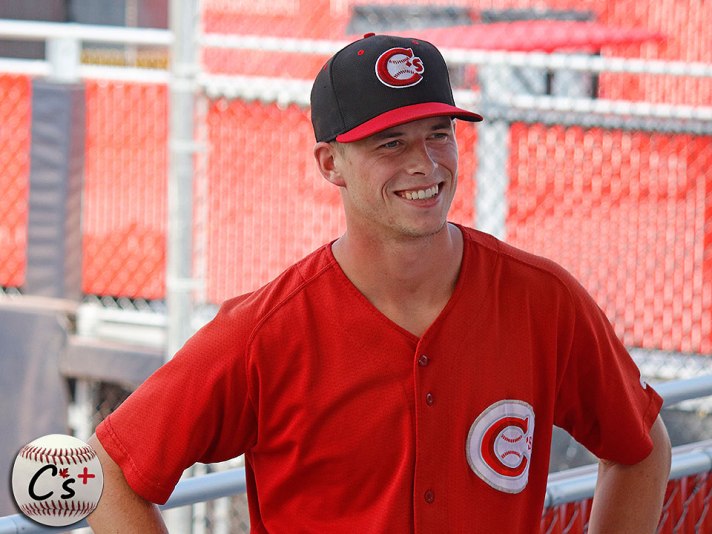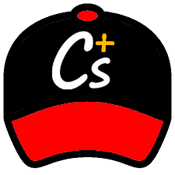
Vancouver Canadians catcher Riley Adams at the Vancouver SABR meeting at Nat Bailey Stadium.
The Vancouver chapter of the Society of American Baseball Research hosted a recent gathering at the home run porch in left field at Nat Bailey Stadium. One of the special guests to speak with the crowd was Vancouver Canadians catcher Riley Adams. The former University of San Diego Torero spent about 20 minutes talking about his baseball career and answering some questions from the audience in afterwards.
The following is a transcription of some of the topics the Blue Jays third round pick and Northwest League All-Star addressed in chronological order.
Adams on playing in Vancouver in his first professional season.
“It doesn’t get much better than this for my first professional summer. Vancouver is a beautiful city so I have zero complaints being able to play baseball in this beautiful city.”
Adams on being drafted by the Chicago Cubs in the 37th round of the 2014 draft out of Canyon Crest Academy in San Diego.
“Out of high school, I definitely developed late. Something that hurt me out of high school, I guess, during my draft year was the fact I did play multiple sports. I played basketball for our high school . I enjoyed the physical side of that, something you don’t get in baseball. (You can) have some fun, push around with the guys and do things like that. I didn’t go to all these giant showcases that high school guys did, playing a lot of tournaments. I think a lot of times now you see in high school a specialization sport I don’t agree with necessarily and I think you got to go out there and play as many things as you want. I knew baseball was what I wanted to do but I enjoyed basketball too. I kind of developed a little late in baseball. I didn’t have a mindset one way or the other to go to college because of the draft, it was ‘Hey, I’m going to college. It was a good opportunity and if the draft was there and if the money they want to invest in me is high enough, of course I’ll go in the draft and play ball. Out of high school, the money they (the Chicago Cubs in 2014) had offered was not enough to pull me away from the park.”
Adams on how he became a catcher.
“Growing up, I was a shortstop. I think almost every kid growing up was a shortstop at some point. I really like that position. I started in high school as a shortstop and after my first year of high school, the varsity team that I was on, we didn’t have a catcher so my coach just asked me out of the blue, ‘Hey, do you want to give it a shot?’ I always liked it, I always thought it was fun to throw the gear on and being involved and everything so it’s been a pretty easy transition for me since I outgrew the shortstop position. I was glad I made that change because I don’t think I’d be in this position right now.”
Adams on why he did not become a pitcher.
“I didn’t know how to throw a curveball or throw strikes”
Adams on trying to hit at Nat Bailey Stadium.
“Basically, at night time, you can’t hit from that Whistler Grey (sign in center field) to right field, it’s almost a graveyard out there. It’s a very tough hitter’s park and I heard this bullpen was only added a few years ago or recently and that hasn’t even helped I think.”
“It’s easier to call a game and catching it because you can play into that , especially when you have guys like Reggie (Pruitt) in center who can track down a fly ball.“
“Certain hitters have certain tendencies. I’m a bigger guy with longer levers with long arms. Naturally, I’m going to have some lift to it, so that’s still my style. I’m going to fly out a few more times, I know that. When I go to other places, it’s the same swing all the time.“
Adams on his style of hitting.
“My power is straight center. I don’t believe I’m a pull hitter. When I was doing my earlier work (batting practice), I was trying to catch you guys a few times (with home runs into the left field porch). I’m still trying to work on pulling the ball. This park, it’s a little tricky, it kind of messes with your head a little bit but you can’t play to the field. I play to the field when I’m catching and calling the game, you play to that but when you’re hitting, you don’t have that much control over it”
Adams on attempting to go for the cycle earlier this season after homering, doubling and singling.
“I was out by a few steps, yeah. It’s been a while since I hit a triple. Catching does wear down your legs so that it something that happens. My speed isn’t what it used to be.“
Adams on the San Diego Padres great and San Diego State coach Tony Gwynn.
“I never played against him when he was coaching. Some of the coaches I had at USD actually, they told a lot of stories. He is one of the greatest hitters of all time.”
Adams on pitch framing or “keeping a strike a strike”.
“One of the biggest things (the Jays) preach here is to not necessarily make balls into strikes. At this level, these umpires, this is their minor leagues too so they’re still learning and trying to get better. You might get away with something when you try to make a ball a strike. When you get higher up, the coaches tell me…When there’s a pitch that’s in there, you got to keep it there.”
Adams on Nat Bailey Stadium vs. Northwest League stadiums.
“We are very lucky here to have this stadium and the fans that are here. I think it ‘s easily the best venue here. I think it’s the most professional stadium (in the Northwest League). For a power hitter, it’s a pretty tough place to be.”
“We were in Hillsboro. That was a very nice field. It’s all turf so you rarely get a bad hop. Boise is not a fun (stadium) to play in when its 100 degrees.”
Adams on game-planning for opposing hitters.
“We like to pitch more towards the pitcher’s strengths rather than the hitter’s weaknesses.”
Adams on trash-talking.
“I’m not too good at trash talking. That’s not my game”
(Editor’s note/pro tip – I wouldn’t recommend trashing talking to Adams because he has a black belt!).
Adams on going through the draft process in high school and college.
“I was a late bloomer out of high school. I think it was the fall of my senior year of high school when I kind of gotten to notice (scouts at the games). I’d say out of the 30 (major league) teams, maybe 16, 17 of them would come over to the house and meet, just kind of go over to get to know you. See what your parents are like, see what I’m like as a person off the field. Out of college, I had the luxury because I grew up in San Diego, I went to school in San Diego, so it was the same exact scouts that I knew in high school…so I built a little bit of a track record with them.”
“My thoughts were always if a team that wants me, that is a team I want. If a team wants to invest in me, I’ll invest in them.”
Adams on the transition from college to professional baseball.
“It’s a lot different at least when you’re hitting, the way that pitchers pitch you, it’s a lot more fastballs down and they like to come in. Obviously, I’m a taller guy so they might want to pitch in with me. It’ s a lot more fastballs that you got to get ready for and every single pitch that you face is sitting 90-plus. In college, it was a little bit lower but still not super low, I just got to get started a little earlier.”
“The biggest things I’ve learned from the coaching in professional baseball versus college is in college, the success of the team is directly related to the coaching. If the team is struggling, then the coaches get fired. Sometimes they have to coached based on for their jobs. Where as the coaches (in pro ball), if you’re struggling, they’re going to just send you down, send you out, whatever. The coaches really are here to coach, they’re here for the right reasons, to help you get better as an individual.”
On catching Nate Pearson and his 100-MPH fastball.
“Nate Pearson is a very special pitcher. No, I don’t have an extra glove (or extra padding for Pearson’s heater) but (Pearson’s fastball) gets on you a little faster. It wakes you up, that’s for sure. Better not miss (catching the ball) or your hands will be sore for a couple of days.”
Other odds and ends…
- Adams said his parents outlawed him playing video games going up and always competed against his older brother Cameron.
- He considers baseball not a game of failure but a game of opportunity.
- Adams says he plans to work on moving side to side and wanting to be “as athletic as I can at the catching position” in the off-season.
- Adams played college summer ball in the Alaska, Northwoods and Cape Cod Leagues
Also a treat to hear @vancanadians catcher @RileyAdams talk about minor league life and his career! pic.twitter.com/u2IjnV2gfB
— BaseballinVANCOUVER (@baseballinvan) August 13, 2017
Great to listen to @BCSportsHall inductee Arnold Hallgren at today’s Vancouver @sabr meeting! pic.twitter.com/9rLfZWRgAm
— BaseballinVANCOUVER (@baseballinvan) August 13, 2017
Also speaking at the SABR gathering was Arnie Hallgren, a two-time batting champion in the minor leagues in 1955 and 1958. The first player from B.C. to make the 40-man roster of a major league team with the Milwaukee Brewers, he was inducted into the BC Sports Hall of Fame in 2005. The Windfield, BC native was teammates with Hall of Famers Hank Aaron, Eddie Mathews and Warren Spahn.
The Vancouver Canadians Offensive Player of the Year award is named in honour of Hallgren and it wouldn’t be a surprise if Adams finds his name on that award at the end of the 2017 season.
Special thanks to Max Weder for hosting the SABR event and to Kirk Sorensen of BaseballInVancouver.com for the invite. A special thanks to Riley Adams who had to endure a Bronx cheer from his teammates when he returned to the field to resume his pregame workout. It’s never a bad thing to spend a sunny Saturday afternoon at the ballpark talking baseball.


